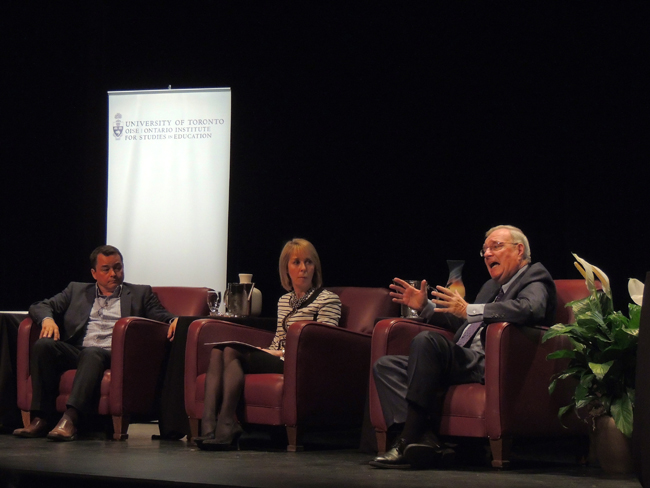Put off roads, not education

By Christine Smith McFarlane
TORONTO – Politicans can put off building roads because they’re trying to reduce budget deficits, says Paul Martin, but that approach doesn’t work when you’re trying to ensure that Native kids know how to read by Grade 3.
The former Prime Minister and AFN National Chief Shawn A-in-chut Atleo exchanged views on First Nations education priorities at an April 18 forum hosted by the Ontario Institute for Studies in Education (OISE) at Hart House Theatre on the University of Toronto campus.
“The issue we have to face is that primary and secondary education in this country is a right — a universal free good; how can the government say they want to build a strong economy when they underfund the youngest and fastest-growing segment of our population?” Martin asked. “The single most immoral thing we can do is to continue underfunding education.
“I can defer the building of a road, or a highway, because you can always build it the next year. But when your concentration on a deficit deprives a six-year-old going into Grade 1 and learning to read by Grade 3, that six-year-old will never catch up.”
After he retired from political life in 2006, Martin and his family established the Martin Aboriginal Initiative , whose activities are focused on contributing to greater First Nation economic self-reliance. An Aboriginal Youth Entrepreneurship Program teaches Aboriginal youth about business and entrepreneurship, to encourage them to complete their high school education and to go onto post-secondary studies.
National Chief Atleo provided statistical context for the R.W.B. Jackson Lecture– First Nations Education in Canada” — which was presented before a sold-out crowd of some 450.
“We have the fastest-growing segment of the Canadian population under the age of 25. (We also have) the highest incarceration rates, and higher dropout rates than graduation rates in some parts of Canada. We currently need 60 schools in First Nations communities right now.
“Yet we have young people in Quebec walking thousands of miles and youth in Northern Ontario marching to raise awareness of the plight of First Nations peoples. This shows an unprecedented engagement of expression, and it’s this generation that’s going to achieve this transformative change we so desperately need for our children and families.”
According to the 2006 Canada census, Atelo said, there were more than one million Aboriginal people in Canada. When compared to non-Aboriginal Canadians, Aboriginal Canadians have a lower education level as well as a lower standard of living. Aboriginal students have a higher high-school dropout rate – 60 per cent on reserve, and 43% in urban centres — compared to 9.5% of non-Aboriginal Canadians. They also have low university graduation rates, higher incarceration rates and an alarmingly high rate of teen suicide – double that of other youth in Canada.
“In some respects, we have come so far, yet we still have a long ways to go,” said the National Chief. “I feel encouraged by this event to be here, where there are hundreds sitting in the audience listening and discussing the biggest social justice issue in Canada — -the plight of First Nations people and education.
Professor Julia O’Sullivan, Dean of the Ontario Institute for Studies in Education, moderated the panel, noting in her opening comments that “First Nations education, indeed Aboriginal education-education for Metis, Inuit, and First Nations peoples is the most important and pressing educational priority in Canada for Aboriginal and non-Aboriginal Canadians. OISE, as Canada’s largest and most influential faculty of education, has a special responsibility to lead in this area. We have, we are and we will.”


